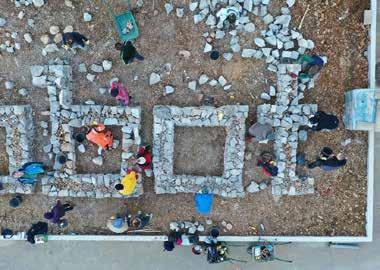
6 minute read
Solid as a Rock The long-lasting beauty of dry-stone masonry
Solid as a Rock
The long-lasting beauty of dry-stone masonry

It is the essence of construction work, the most elemental of building techniques: carefully stacking one stone upon another, fitting one rock next to another, layer by layer without mortar or other materials to keep them together except gravity. Drystone walls and houses seem to be at ease with their natural surroundings, harmoniously fitting in as if they have always been there. The seemingly simple stone constructions have not only sculpted and moulded the European landscape, they are deeply rooted in local communities. They not only look good, but they are also sustainable and very useful in creating micro-climates, enhancing biodiversity and preventing soil degradation. The techniques, some of which have been in use since prehistoric times, have been perfected over the centuries, handed down from one generation to the


next. As dry-stone techniques are sensible and practical, it is therefore no surprise that we can find them all over Europe. This perfect example of shared European heritage even led, in 2018, to a successful UNESCO application by eight European countries (Croatia, Cyprus, France, Greece, Italia, Slovenia, Spain, Switzerland). The art of dry-stone techniques is now inscribed on the Representative List of the Intangible Cultural Heritage of Humanity. What is surprising is that these techniques, which seem to fit so perfectly with the new European Union Green Deal, are disappearing at an alarming rate, especially in South East Europe where we can discover some of its most extraordinary and distinctive examples.
In the Eastern Adriatic, heritage organisations are trying to turn the tide. By their very definition, dry-stone structures are locally built from local materials, and are an intrinsic part of local heritage. That means that renovation of walls and buildings and the revitalisation of dry-stone traditions have to be organised in the form of small-scale grassroot invention projects. The first step is convincing the small communities that their traditional and often derelict heritage is of European importance and that preserving it will improve their livelihoods and economic prosperity.

4 grada Dragodid – who won a European Heritage Award in 2011 for their outreach work – is one of the organisations in a race against the clock to transfer knowledge and skills to new generations. The team, which consists mostly of volunteers – young professionals and students of heritage and landscape, gather and document construction techniques, and use digital, crowd-sourced data (suhozid. hr, dragodid.org). They have been active throughout Croatia, especially in Dragodid (Island of Vis) and Petrebišća (Nature Park Učka). Dragodid is a small village on Vis Island and very much off the beaten track. It was abandoned over 50 years ago but has been restored and revitalised through workshops and summer camps of dedicated volunteers of the organisation. The abandoned dry-stone seasonal village Petrebišća in the Učka mountains is also actively being restored and rebuilt.
Another dry-stone treasure can be found in Serbia’s Stara Planina Nature Park. The stone settlement of Gostuša seems to have grown naturally from the surrounding mountains. The buildings are not only a testimony to the complex history of this part of Europe, they are simply magnificent to look at, and fit well with the natural landscape. The village was in danger of slowly disappearing, a forgotten victim of the ever-changing modern times. Since the 1970s, most people had left the tiny community to seek a better life in the city. The Institution for the Cultural Monuments Preservation of Niš, under the guidance of architect conservator Elena Vasić Petrović, came to the rescue. Their conservation study of Gostuša won a European Heritage Award Grand Prix in 2016. The group of researchers not only consisted of architects and heritage professionals, but also of experts in ethnology, archaeology, photography and history. This multi-disciplinary approach helped to put the village back on the map and to increase its potential as a tourist destination. In several campaigns, experts and students created a strategic framework for the sustainable development and proposed an official protected monument status for the village. The project also documented all the buildings with hundreds of architectural drawings and photos. The study is a key example of heritage-led regeneration of the countryside. The village is now ready for its international close-up.



These examples prove that the restoration of dry-stone masonry buildings and walls has great potential in South East Europe. As is well-known from examples

An exceptional example of drystone craftsmanship is the tiny Dalmatian island of Baljenac in Croatia. The tiny stone droplet in the azure blue water of the Adriatic is completely covered in dry-stone fences, more than 23 kilometres of them. It is a man-made miracle of masonry, separating small parcels of agricultural land owned by the farmers of nearby Kaprije island. Seen from above it looks like the islet is a giant fingerprint. Kaprije itself also has an almost impossible number of dry-stone walls, as do most of the islands in the region. from, for instance, the United Kingdom, Ireland and Scandinavia, the revitalisation of these charming and much-loved buildings and walls gives a welcome boost to local economies. The fact that these ancient building practices tick all the right boxes of sustainability in a new environmentally conscious Europe should convince authorities on all levels to support and stimulate the preservation of this European heritage with increasing enthusiasm and perseverance.
It is the essence of construction work, the most elemental of building techniques: carefully stacking one stone upon another, fitting one rock next to another, layer by layer without mortar or other materials to keep them together except gravity. Drystone walls and houses seem to be at ease with their natural surroundings, harmoniously fitting in as if they have always been there. The seemingly simple stone constructions have





